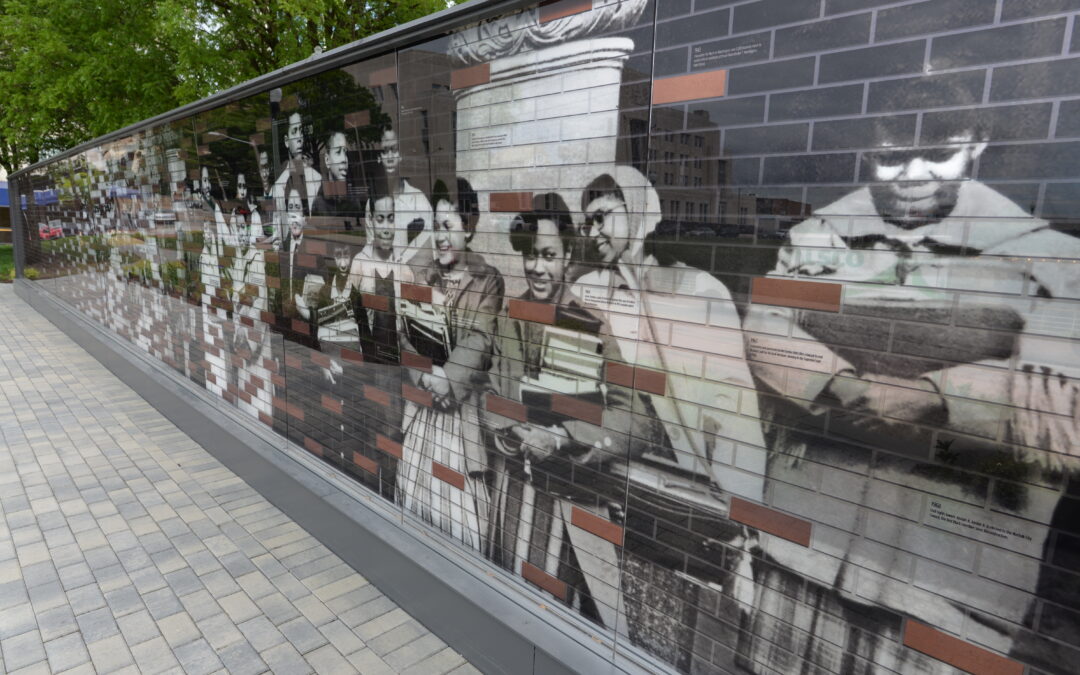By Betsy DiJulio
From the Berlin Wall to the US-Mexico Border Wall, the West Bank Wall and even the conceptual “fourth wall” in theatre, walls, often steeped in controversy, divide, barricade, contain, and, conversely, keep out.
But in 1979, Maya Lin, then a 20-year-old Asian-America senior at Yale University, won a nationwide competition sponsored by the Vietnam Veterans Memorial Fund to design the Vietnam Veterans Memorial. Out of 1,400 entries submitted by blue chip architects, landscape architects, and sculptors, her minimal, sunken V-shaped black granite wall inscribed with the names of nearly 58,000 deceased or missing soldiers was chosen, eventually becoming known simply as “The Wall.”
During the selection process, Lin faced intense congressional grilling, even public and venomous criticism, for her concept which invites visitors on a metaphorical—and continuing—journey. Along the way, we are asked to confront death absent any heroism traditionally associated with war memorials. Nothing, though, is ever about one thing, and the controversy raging around the memorial highlighted the complexities of our country’s deep division over the Vietnam War, as well as over what constitutes a fitting memorial or commemorative structure. Today, far from an obstacle, The Wall attracts some 5 million visitors annually and is the most visited memorial on the National Mall in Washington, D.C.
But what does that have to do with the end of massive resistance? For the uninitiated, Norfolk was front and center in the national school segregation/desegregation battle of the mid-20th century. In 1956 Virginia’s state government adopted a policy they called Massive Resistance to block the federally mandated desegregation of public schools (Brown vs. Board of Education, 1954).
The Norfolk School Board conducted extensive interviews with 150 black students who applied to attend white schools. Only 17, who would come to be known as the Norfolk 17, were deemed suitable to attend. In the fall of 1958, as they prepared to enter their white schools, officials delayed the opening of all schools until late September with one caveat: the six middle and high schools where these 17 students were enrolled were padlocked shut.
As the result of a lawsuit filed by the parent of a white Norfolk student, the Supreme Court deemed the public school closings unconstitutional and in February 1959, the Norfolk 17 were finally allowed to attend class, but not without first undergoing extensive mental, emotional, and psychological testing. The white students due to graduate that year became known as “The Lost Class of 1959.” Most went without schooling, while some moved in with relatives in other states, some were homeschooled, and others joined the military. Meanwhile, for those six months from September 1958 to February 1959, the NAACP ensured that the Norfolk 17 would be prepared to excel at their white schools when the doors were unchained by arranging for rigorous tutoring in the basement of the Bute Street First Baptist Church.
Though Karen Rudd, Norfolk’s Art Manager, recounts that the 17 all have quite different, individual, and hard-earned stories to tell, they were all physically and emotionally harassed and abused throughout their school careers by classmates and adults alike, despite contrary media accounts at the time. Upon reflection, the living members of the group credit their strong faith with helping them endure the daily assaults and develop fortitude, asserting that they would do it all over again to establish a path forward for those who followed.
It was not until a 1968 Supreme Court Ruling (Green et a v. County School Board of New Kent County) that desegregation commenced on a large scale and in the 1970s a court order required Norfolk to bus students to help ensure better integration. But, when released from the order in 1986, schools were re-segregated along neighborhood lines.
On April 27 of this year, concluding a protracted process, the City of Norfolk welcomed 200 attendees to the dedication of a commemorative wall in Flatiron Park entitled End of Mass Resistance. Among the guests were six of the eight living members of the Norfolk 17 who were able to travel as well as family members of the others. This local example is a wall that, like Lin’s, is not intended to be a barrier—rather a symbolic dismantling of a barrier—and is the embodiment of an ongoing journey. As such, it takes its place within a broad public art movement for which, according to Rudd, Lin paved the way when she “took down the white man on horseback.”
Norfolk’s newest public art installation—and most expensive at $625,000—is an 8’ x 57’ translucent wall that, as Norfolk Mayor Kenny Alexander remarked at the dedication ceremony, serves as a reminder of “the courage and persistence of the Norfolk 17 and the Lost Class.” Designed by Texas-based RE:Site artists Shane Albritton and Norman Lee, the image of a redbrick school wall dissolves, brick-by-brick, into now iconic black and white photographs: chains on the entrance to a Norfolk school which gives way to some of the 10,000 white students whose educations were disrupted followed by the Norfolk 17. The composition concludes with a poem entitled Seventeen Ways, commissioned by the artists from Tim Seibles, ODU professor and former Poet Laureate of Virginia, who collaborated with members of the 17 (see sidebar). More than 40 of the bricks are inscribed with a meticulously researched timeline by Lydia Bean, Ph.D.
The nearly inevitable prolongation of a process such as this helps ensure what Rudd cautions against: “not telling your history too soon.” Discussions around how to commemorate the end of Massive Resistance waxed and waned for some 14 years beginning in 2009. That year, City officials formally apologized to the Norfolk 17 on the 50th anniversary of their admission to white schools and bestowed honorary diplomas on the Lost Class during several days of symposia and events. This proved to be the catalyst for the Council to take their idea to the Norfolk Arts Commission.
Early on, a design by Walter Hood, a professor at the University of California at Berkeley, despite being quite far along in the development process, was never approved. Hood’s abstract and conceptual tensegrity structure featuring black and white tubes and voice recordings would have been erected on Civic Plaza at City Hall. In hindsight, Rudd feels that such a contemporary piece might not have been the right defining statement regarding this deeply fraught chapter of Norfolk’s history.
In addition, the project kept getting postponed, with much discussion about the appropriateness of the proposed site. But over the years, the national conversation changed and, to Rudd’s way of thinking, allowed or perhaps encouraged us to embrace our discomfort around issues of racism, both individual and institutional. Many other sites were considered, but none had the prestige of a downtown site. When Flatiron Park was identified, Rudd says she felt it seemed made for the project. The site of a former bank building, the piece of land is elevated so that the commemorative wall appears elevated atop a pedestal.
However, it was not her decision to make. A carefully curated committee of stakeholders and other experts conducted extensive interviews with the Norfolk 17 while mindfully and scrupulously vetting every decision related to the project, including the stated goal of telling “a multilayered story” about this part of Norfolk’s past. As Rudd notes about all public art projects, she cannot defend the art; she can only defend the process.
Though Pink Floyd was likely far from the minds of the wall’s creators, this public project seems to pose a question to viewers: are we going to be—or remove—another brick in the wall of racial inequity?
WANT TO SEE? End of Massive Resistance, Flatiron Park, 114 W. Charlotte Street, Norfolk.
Seventeen Ways
By Tim Seibles
Beyond resistance, beyond the locked doors
of hate, Hope—a kind of fuel for walking
seventeen ways into history, into a future
beyond those who’d been blinded
by their own bright skin.
What did it mean to enter the halls
packed with snarling faces, to live every day
under the insults, the sharpening threats?
Here, now, it’s easy to forget—easy
to think “it wasn’t so bad.” Close your eyes.
You can still see each of them alone
in class: bobby socks, polished shoes,
pressed slacks, good skirts, eyes lit
by this one rough chance.
The Seventeen
given no other way but through
the festering mob: their fellow students
caught in the old snare of bigotry.
Why did none of them turn back, go home
when Cruelty spat in their black faces?
Be here with them for a moment.
Open your eyes. Try to remember
what has been won,
what it means
after all the madness, to see
the doors everywhere, finally open.




